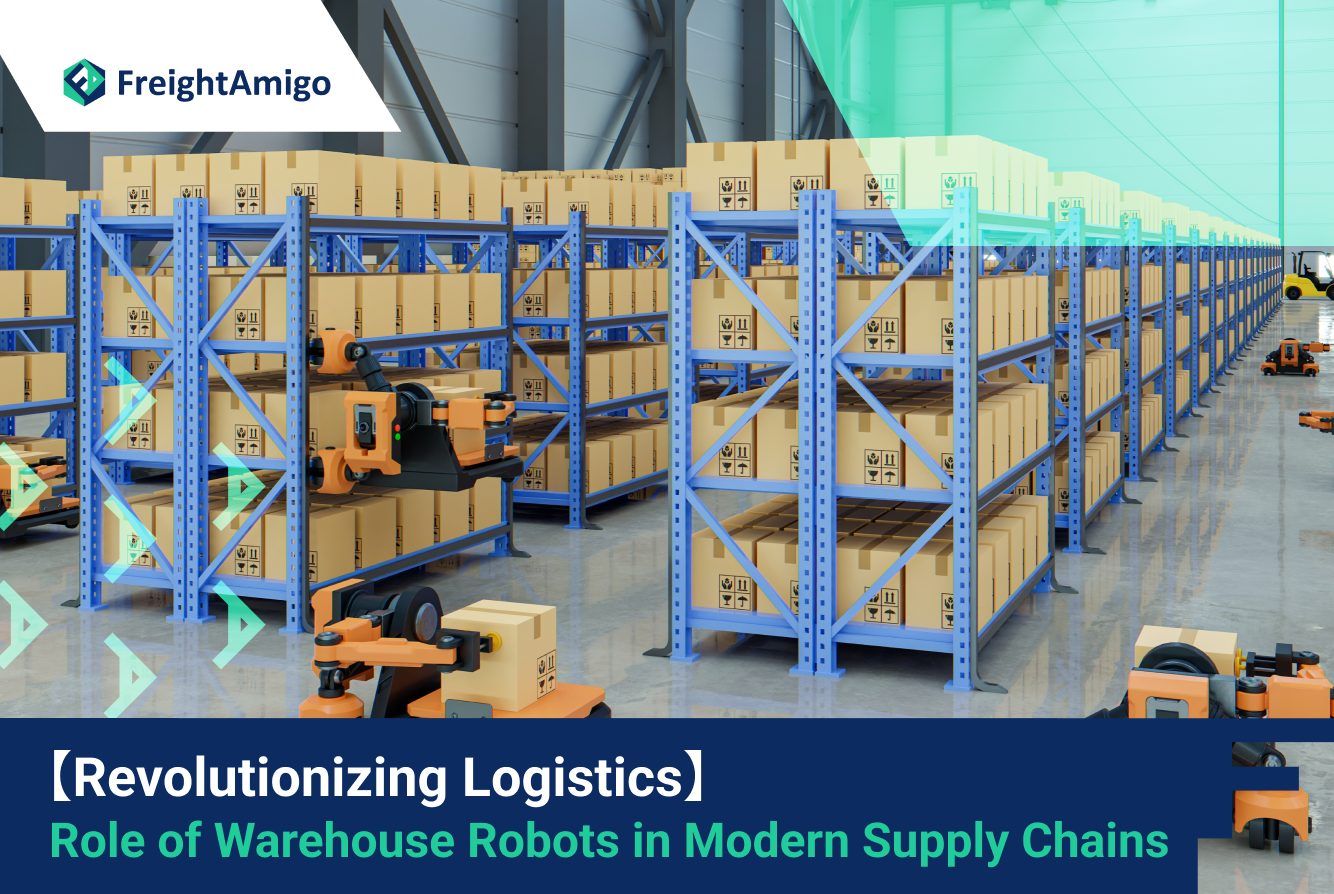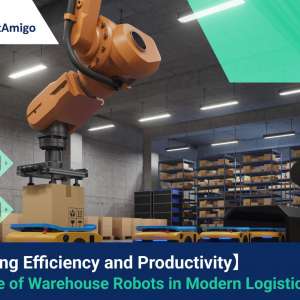Author Name: Tiffany Lee – Marketing Analyst at FreightAmigo
Introduction to Warehouse Robots
In the world of logistics, warehouse robots are becoming increasingly prominent. These autonomous machines are designed to handle a variety of tasks that were previously performed by humans. From picking and packing to sorting and transporting goods, warehouse robots are transforming traditional warehouse operations. They are not only enhancing productivity but also reshaping the entire supply chain management system.
The application of warehouse robots varies across industries. From e-commerce giants to small retail businesses, many are embracing the robotic revolution to stay competitive. The rise of warehouse robots, however, is not merely a result of technological advancement. It reflects a broader shift in the logistics sector towards automation and digitalization, driven by the needs of today’s fast-paced, demand-driven market.
The introduction of warehouse robots is not without challenges. These range from initial setup costs to the need for ongoing maintenance and updates. Despite these hurdles, the benefits they bring to companies are undeniable. Warehouse robots are fast becoming an integral part of modern logistics, promising to revolutionize the industry in the near future.
Want To Compare The Best Express, Air Freight, Sea Freight, Rail Freight & Trucking Rates So As To Have Better Control On Cost?
Advantages of Warehouse Robots
Warehouse robots offer several advantages that are transforming the logistics sector. They significantly enhance operational efficiency, allowing for faster and more accurate order fulfillment. Unlike human workers, robots can work 24/7 without rest, thereby increasing productivity. They also reduce the risk of errors and accidents, improving overall safety in the warehouse.
Moreover, warehouse robots can reduce labor costs, as they require less human intervention. This is particularly beneficial in regions where labor costs are high. Robots can also operate in environments that are hazardous for humans, such as cold storage facilities or areas with heavy goods. This further expands their utility in various industrial settings.
Finally, warehouse robots can be easily integrated with other technologies, such as warehouse management systems (WMS) or enterprise resource planning (ERP) systems. This allows for better tracking and management of inventory, contributing to more streamlined operations and enhanced supply chain visibility.
Warehouse Robots and the Modern Supply Chain
In the context of the modern supply chain, warehouse robots play a vital role. They are instrumental in meeting the growing demands for speed, accuracy, and efficiency. E-commerce, for instance, requires rapid order fulfillment and delivery to meet customer expectations. Warehouse robots can help achieve this by speeding up picking and packing processes and reducing errors.
Warehouse robots also support the trend towards customization and personalization in retail. They can handle individual orders efficiently, allowing companies to offer a wider range of products and services. Furthermore, they can adapt quickly to changes in demand, helping businesses stay agile and responsive in a volatile market.
In addition, warehouse robots contribute to sustainability in the supply chain. They can reduce energy consumption and waste, contributing to greener operations. By automating repetitive tasks, they also free up human workers to focus on more value-added activities, fostering innovation and growth.
The Role of Warehouse Robots in Improving Logistics
Warehouse robots are a key driver of improvement in logistics. They help companies overcome common challenges such as labor shortages, high operational costs, and complex inventory management. By automating repetitive tasks, they allow workers to focus on more strategic activities, improving overall business performance.
Moreover, warehouse robots enhance accuracy and precision in logistics operations. They eliminate human error in tasks such as picking and packing, reducing the risk of misshipments and returns. They also enable real-time inventory tracking, preventing stockouts and overstocking.
Furthermore, warehouse robots can significantly cut down lead times. They can pick and pack orders faster than human workers, ensuring timely deliveries. This not only improves customer satisfaction but also strengthens competitive advantage in the fast-paced e-commerce market.
Types of Warehouse Robotics
There are various types of warehouse robotics, each designed for specific tasks. Automated guided vehicles (AGVs) and autonomous mobile robots (AMRs) are used for transporting goods within the warehouse. They follow pre-defined routes and can navigate around obstacles.
Picking robots are designed to pick items from shelves, while sorting robots sort items based on certain criteria. Packing robots, on the other hand, pack items into boxes or pallets for shipment. There are also specialized robots for tasks such as loading and unloading, palletizing, and depalletizing.
Moreover, there are robotic storage and retrieval systems (AS/RS) that store and retrieve items automatically. These systems can greatly enhance space utilization and inventory control. Besides, there are collaborative robots or “cobots” that work alongside human workers, offering flexibility and efficiency in various tasks.
Choosing the Right Warehouse Robots for Your Business
Choosing the right warehouse robots for your business depends on several factors. These include the nature and volume of your operations, the layout of your warehouse, and your specific business goals. It’s important to assess your current processes and identify areas where automation can bring the most benefits.
You should also consider the scalability of the robotic solution. As your business grows, you might need to handle larger volumes of goods or introduce new products. The robots should be able to adapt to these changes without requiring major modifications.
Moreover, consider the ease of integration with your existing systems. The robots should be compatible with your WMS or ERP system to ensure seamless data exchange and coordination. Finally, consider the total cost of ownership, which includes the initial purchase cost, installation, maintenance, and potential upgrades.
Future Outlook for Warehouse Robotics
The future of warehouse robotics looks promising. As technology advances, robots are becoming more sophisticated and versatile. They are expected to take on more complex tasks and operate in more diverse environments. Advances in artificial intelligence and machine learning are enabling robots to learn from their experiences and improve their performance over time.
Moreover, the trend towards Industry 4.0, or the fourth industrial revolution, is driving the adoption of warehouse robotics. This revolution is characterized by the integration of digital and physical technologies, leading to more automated, intelligent, and connected operations. Warehouse robots are at the forefront of this transformation, playing a crucial role in shaping the future of logistics.
In terms of market growth, the warehouse robotics market is projected to grow at a significant rate in the coming years. This growth is fueled by factors such as the rise of e-commerce, labor shortages, and the need for faster and more efficient logistics operations. Despite potential challenges, such as high initial costs and technical issues, the benefits of warehouse robotics are expected to outweigh the drawbacks, leading to wider adoption across industries.
Conclusion
In conclusion, warehouse robots are revolutionizing logistics, bringing numerous benefits to businesses and the supply chain as a whole. They are enhancing efficiency, accuracy, and safety in warehouse operations, while reducing costs and supporting sustainability. Despite the challenges, their adoption is likely to continue to rise, driven by technological advancements and market demands.
If you’re considering integrating warehouse robots into your operations, it’s important to carefully evaluate your needs and options. The right robotic solution can significantly improve your logistics performance, giving you a competitive edge in today’s dynamic market.
With the ongoing advancements in technology, the role of warehouse robots in logistics is set to become even more significant. They are not just a trend, but a key component of the future of logistics. Embracing this robotic revolution is no longer an option, but a necessity for businesses seeking to thrive in the modern supply chain landscape.
There Are Different Options For Cargo Transportation. If You Want To Choose The Most Convenient And Suitable Solution, It Is Best To Have The Full Support Of Logistics Experts! If You Are Planning To Ship Goods Overseas, Please Go To The FreightAmigo Page For Inquiries.
===
Read More:
【Logistics News】Singapore to Sign Declaration on Green Shipping Corridors
FreightAmigo Won Startup Grand Award In TechChallenge — Digitising Trade Finance
Sailing Schedule: Streamlining Logistics Operations for Efficient Shipments
===
If you have any inquiries on logistics/supply chain, feel free to contact FreightAmigo now:
Chat with us online OR
Phone : +852 28121686
WhatsApp: +852 27467829









































